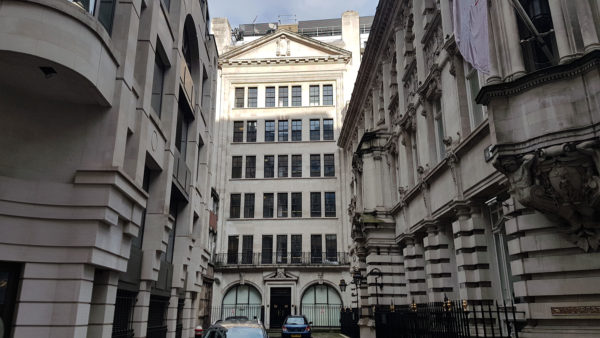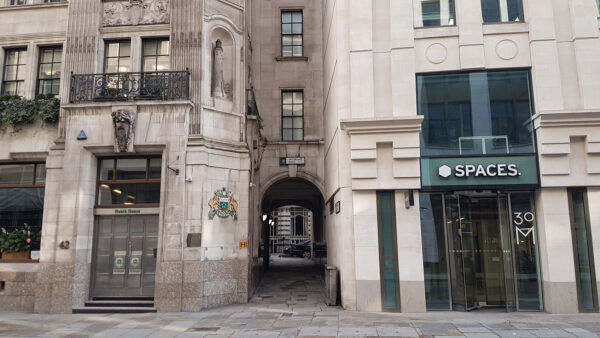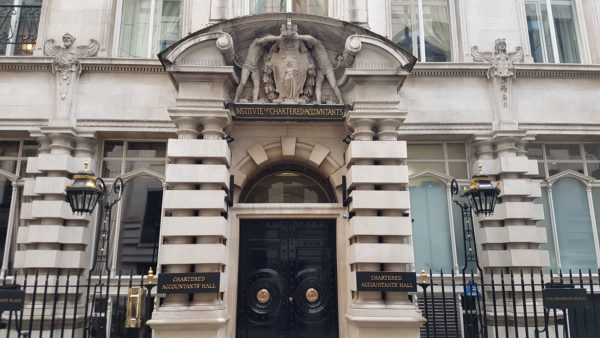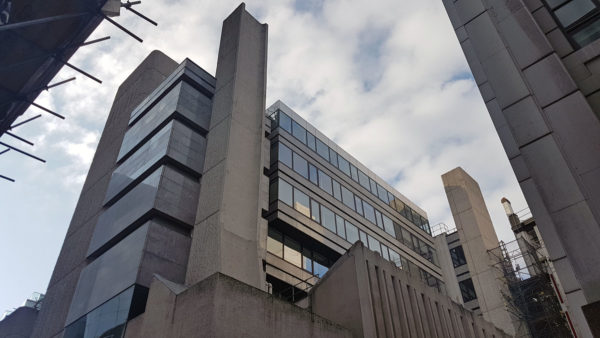A short alley with a narrow covered passage that then curves around to a grand street with impressive buildings.
The layout of the streets and alleys in the area is attributed to early developments in the Saxon and Norman periods, initially as streets surrounded fields, and slowly as the fields themselves were filled in with more housing.
Leading of the ancient Swan Alley (now Great Swan Alley), it was laid out in the 17th century by the Clothworkers Livery Company, replacing a cluster of smaller buildings, that also backed onto a large garden.
Originally known as Coleman Street Buildings, it was renamed as Moorgate Place sometime in the 19th century, which is also when the remaining smaller buildings were absorbed into the large blocks that dominate the area today.
One black, facing Moorgate is a relatively new one, being a 1980s rebuild, and a more recent refurbishment. Do look up if standing by the covered alley though, as in the chamfered corner of the opposite building is a lighthouse. Officially 42 Moorgate, and today the Habib Bank, this was once the headquarters of the Ocean Accident & Guarantee Corp, and the building designed by Aston Webb. Apparently, the light in the top used to work.
The most notable of the other buildings that line the alley is a building of two very different aspects.
Facing the alley is the classic late Victorian grand stone facade of a steel supported building, in the Baroque Revival style — the Institute of Chartered Accountants. It was described by Pevsner as ’eminently original and delightfully picturesque’, but what really sets the building apart is the upper levels, with statues representing Arts, Sciences, Crafts, Education, Commerce, Manufacture, Agriculture, Mining, Railways, Shipping, India, the Colonies, and Building, and with Justice on the corner.
However, if you’re in the area, wander around to the back of the building for a totally different experience — a post-war building that’s still part of the same estate as the Victorian grand frontage.
Here though perpendicular concrete dominates with hidden staircases and utilities clearly shown off in the structure of the building so that there are minimal supporting pillars internally. The rough finish is known as Elephant Trunking, as it was first used architecturally on London Zoo’s elephant enclosure.
Pevsner noted that: ”here is proof, if proof were needed, that the uncompromisingly new can go with the old, if handled by an appreciative and imaginative architect.”
In its own right it’s a wonderful building, but that it’s linked to the older beside it is a delightful contrast. You could easily show a friend the front, then stun them with the contrast of the rear.











Of course,the ICAEW extension was designed by the great Sir William Whitfield, who died in March this year (2019). The sensitivity referred to by Pevsner is also evidenced in his tudor style turrets of the distinctive Richmond House in Whitehall, about to be decimated internally by the temporary relocation of Parliament. A great architect sadly missed.